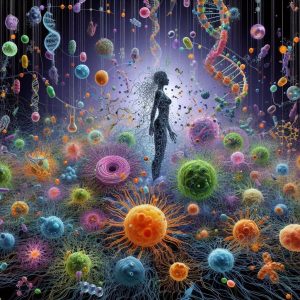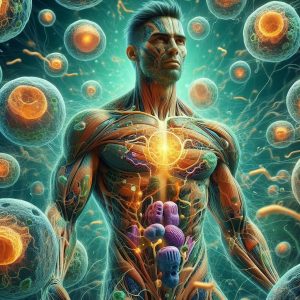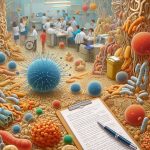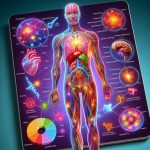Key Components of Metabolism
Metabolism can be divided into two main categories: catabolism and anabolism.
- Catabolism: The breakdown of molecules to obtain energy. For example, the breakdown of glucose in cellular respiration. Learn more at NCBI.
- Anabolism: The synthesis of all compounds needed by the cells. An example is the synthesis of proteins from amino acids. Discover more at Britannica.
Metabolism
Table: Key Metabolic Processes
Functions of Metabolism
Metabolism is crucial for several biological functions:
- Energy Production: Metabolic pathways like glycolysis and the citric acid cycle generate ATP, the energy currency of the cell. For more details, visit Khan Academy.
- Biosynthesis: Anabolic processes create essential biomolecules, including nucleic acids, proteins, and lipids, which are necessary for cell structure and function. Learn more at NCBI.
- Detoxification: Metabolism helps in detoxifying harmful substances and excreting waste products. For further reading, visit NCBI.
Metabolic Pathways
Metabolic pathways are series of chemical reactions occurring within a cell.
Types of Metabolic Pathways
Metabolic pathways can be classified into three main types: linear, cyclic, and branched. Each type plays a unique role in cellular metabolism.
Linear Pathways
Linear pathways consist of a series of reactions where the product of one reaction serves as the substrate for the next. An example of a linear pathway is glycolysis, the process by which glucose is converted into pyruvate, yielding ATP and NADH. For more on glycolysis, visit Khan Academy.
Cyclic Pathways
Cyclic pathways involve a series of reactions where the final product regenerates the initial substrate. A prime example is the citric acid cycle (or Krebs cycle), which plays a key role in the aerobic respiration of cells. It converts acetyl-CoA into carbon dioxide and high-energy molecules. Learn more at NCBI.
Branched Pathways
Branched pathways can diverge into two or more directions, leading to the production of different products. An example is the biosynthesis of amino acids, where common intermediates can lead to the formation of various end products. Discover more about these pathways at NCBI.

Key Metabolic Pathways
| Pathway | Description | Location |
|---|---|---|
| Glycolysis | Breakdown of glucose to pyruvate, producing ATP and NADH | Cytoplasm |
| Citric Acid Cycle | Oxidation of acetyl-CoA to CO2 and high-energy molecules | Mitochondria |
| Electron Transport Chain | Series of complexes that transfer electrons, producing ATP | Inner mitochondrial membrane |
| Amino Acid Biosynthesis | Formation of amino acids from common intermediates | Cytoplasm |
Regulation of Metabolic Pathways
The regulation of metabolic pathways is critical for maintaining cellular homeostasis. This regulation is achieved through various mechanisms, including allosteric regulation, feedback inhibition, and covalent modification. For a deeper understanding, visit NCBI.
Examples of Metabolic Pathway Regulation
- Allosteric Regulation: Enzymes can be activated or inhibited by molecules that bind to a site other than the active site. An example is the regulation of phosphofructokinase in glycolysis. Learn more at NCBI.
- Feedback Inhibition: The end product of a pathway inhibits an earlier step. For instance, the end product of the citric acid cycle can inhibit enzymes in the cycle. Discover more at NCBI.
- Covalent Modification: Enzymes can be regulated by the addition or removal of chemical groups, such as phosphorylation. This mechanism is seen in the regulation of glycogen phosphorylase. For further details, visit NCBI.
Regulation of Metabolism
Metabolism is tightly regulated by various mechanisms to maintain homeostasis. Hormones such as insulin and glucagon play key roles in regulating metabolic pathways. For more information, see Britannica.
Metabolic Disorders
Disruptions in metabolic processes can lead to various disorders, including diabetes, obesity, and metabolic syndrome. Understanding these disorders is crucial for developing effective treatments. Learn more at WHO.
Common Metabolic Disorders
There are several well-known metabolic disorders, each with its own unique characteristics and impacts on health. Some of the most common metabolic disorders include:
Diabetes Mellitus
Diabetes is a condition characterized by high blood glucose levels due to the body’s inability to produce or use insulin effectively. This disorder can lead to serious complications if not managed properly. For more information, visit American Diabetes Association.
Phenylketonuria (PKU)
PKU is a genetic disorder where the body cannot break down the amino acid phenylalanine. High levels of phenylalanine can cause intellectual disabilities and other health issues. Learn more about PKU at NCBI.
Hyperthyroidism
Hyperthyroidism is a condition where the thyroid gland produces excessive amounts of thyroid hormones, accelerating the body’s metabolism. This can result in rapid weight loss, increased heart rate, and nervousness. More details can be found at American Thyroid Association.
Gaucher Disease
Gaucher disease is a genetic disorder caused by the deficiency of an enzyme needed to break down fatty substances. This can lead to organ enlargement and bone abnormalities. Further information is available at NCBI.
Impact of Metabolic Disorders
Metabolic disorders can have wide-ranging effects on an individual’s health and quality of life. These effects can include growth problems, developmental delays, and chronic health conditions. For a deeper understanding, visit Metabolism URL.
Diagnosis and Treatment
Early diagnosis and treatment are crucial for managing metabolic disorders effectively. Diagnostic methods can include genetic testing, blood tests, and metabolic screenings. Treatment approaches vary depending on the specific disorder but may involve dietary changes, medication, and enzyme replacement therapy. More information can be found at NCBI.
Prevention and Management
Preventing metabolic disorders can be challenging, especially when they are genetic. However, lifestyle changes such as a balanced diet, regular exercise, and routine medical check-ups can help manage symptoms and improve quality of life. For preventive strategies, visit CDC.
Common Metabolic Disorders and Key Details
| Disorder | Cause | Symptoms | Treatment |
|---|---|---|---|
| Diabetes Mellitus | Insulin deficiency/resistance | High blood glucose, fatigue, frequent urination | Insulin therapy, lifestyle changes |
| Phenylketonuria (PKU) | Genetic mutation | Intellectual disability, seizures, behavioral problems | A special diet low in phenylalanine |
| Hyperthyroidism | Overactive thyroid gland | Weight loss, rapid heartbeat, nervousness | Medications, radioactive iodine, surgery |
| Gaucher Disease | Enzyme deficiency | Organ enlargement, bone pain, fatigue | Enzyme replacement therapy, medication |
Key Metabolic Pathways in details
Overview of Glycolysis
Glycolysis involves a series of ten enzyme-catalyzed reactions that convert glucose into pyruvate. This process not only generates energy in the form of ATP (adenosine triphosphate) but also produces NADH (nicotinamide adenine dinucleotide), which is used in other metabolic pathways. For a detailed pathway, visit Khan Academy.
Phases of Glycolysis
Glycolysis can be divided into two main phases:
Preparatory Phase
In the preparatory phase, glucose is phosphorylated and converted into fructose-1,6-bisphosphate. This phase consumes two molecules of ATP.
Payoff Phase
In the payoff phase, fructose-1,6-bisphosphate is split into two three-carbon molecules, which are further processed to generate four molecules of ATP and two molecules of NADH. The end product of glycolysis is pyruvate.
Key Enzymes in Glycolysis
Several key enzymes are involved in glycolysis, each playing a crucial role in catalyzing specific reactions. Some of the important enzymes include:
- Hexokinase: Catalyzes the phosphorylation of glucose to glucose-6-phosphate.
- Phosphofructokinase-1 (PFK-1): Regulates the conversion of fructose-6-phosphate to fructose-1,6-bisphosphate.
- Pyruvate Kinase: Catalyzes the final step of glycolysis, converting phosphoenolpyruvate to pyruvate.
For more information on the enzymes involved in glycolysis, visit NCBI.
Significance of Glycolysis
Glycolysis is significant for several reasons:
- It provides a quick source of energy, especially in anaerobic conditions.
- It supplies intermediates for other metabolic pathways, such as the citric acid cycle and the pentose phosphate pathway.
- It is a universal pathway present in nearly all living organisms.
For a comprehensive review on the significance of glycolysis, visit Glycolysis URL.
Glycolysis Overview
| Step | Enzyme | Reaction |
|---|---|---|
| 1 | Hexokinase | Glucose to glucose-6-phosphate |
| 2 | Phosphofructokinase-1 (PFK-1) | Fructose-6-phosphate to fructose-1,6-bisphosphate |
| 3 | Pyruvate Kinase | Phosphoenolpyruvate to pyruvate |
Steps of the Citric Acid Cycle
The Citric Acid Cycle involves a series of enzyme-catalyzed reactions that systematically degrade acetyl-CoA into carbon dioxide and water, while generating high-energy electron carriers (NADH and FADH2) and GTP (or ATP). The main steps include:
- Citrate Formation: Acetyl-CoA combines with oxaloacetate to form citrate, catalyzed by citrate synthase.
- Isomerization: Citrate is converted into isocitrate by aconitase.
- Oxidative Decarboxylation: Isocitrate is oxidized to alpha-ketoglutarate by isocitrate dehydrogenase, producing NADH and CO2.
- Further Decarboxylation: Alpha-ketoglutarate is converted to succinyl-CoA by alpha-ketoglutarate dehydrogenase, producing NADH and CO2.
- Conversion to Succinate: Succinyl-CoA is converted to succinate, producing GTP (or ATP).
- Oxidation to Fumarate: Succinate is oxidized to fumarate by succinate dehydrogenase, producing FADH2.
- Hydration to Malate: Fumarate is hydrated to malate by fumarase.
- Regeneration of Oxaloacetate: Malate is oxidized to oxaloacetate by malate dehydrogenase, producing NADH.
For more detailed steps of the Citric Acid Cycle, visit Khan Academy.
Energy Yield of the Citric Acid Cycle
The Citric Acid Cycle is highly efficient in energy production. For each acetyl-CoA molecule that enters the cycle, the following high-energy molecules are produced:
- 3 NADH
- 1 FADH2
- 1 GTP (or ATP)
These molecules are then used in the electron transport chain to produce ATP, the primary energy currency of the cell. For an in-depth look at the energy yield, visit NCBI.
Key Enzymes in the Citric Acid Cycle
Several key enzymes are involved in the Citric Acid Cycle, each catalyzing specific reactions. Some of the important enzymes include:
- Citrate Synthase: Catalyzes the first step, converting acetyl-CoA and oxaloacetate to citrate.
- Isocitrate Dehydrogenase: Catalyzes the oxidation of isocitrate to alpha-ketoglutarate, producing NADH and CO2.
- Alpha-Ketoglutarate Dehydrogenase: Catalyzes the conversion of alpha-ketoglutarate to succinyl-CoA, producing NADH and CO2.
- Succinate Dehydrogenase: Catalyzes the oxidation of succinate to fumarate, producing FADH2.
For more information on the enzymes of the Citric Acid Cycle, visit NCBI.
Summary of the Citric Acid Cycle
| Step | Enzyme | Product |
|---|---|---|
| 1 | Citrate Synthase | Citrate |
| 2 | Aconitase | Isocitrate |
| 3 | Isocitrate Dehydrogenase | Alpha-Ketoglutarate |
| 4 | Alpha-Ketoglutarate Dehydrogenase | Succinyl-CoA |
| 5 | Succinyl-CoA Synthetase | Succinate |
| 6 | Succinate Dehydrogenase | Fumarate |
| 7 | Fumarase | Malate |
| 8 |
Functions of Amino Acids in Metabolism
Amino acids serve multiple functions in the body, including:
- Protein Synthesis: Amino acids are linked together in specific sequences to form proteins, which are essential for cell structure and function.
- Enzyme Production: Enzymes, which catalyze biochemical reactions, are made up of amino acids.
- Neurotransmitter Synthesis: Certain amino acids are precursors to neurotransmitters, which are crucial for nervous system function.
- Energy Production: Amino acids can be used as a source of energy, particularly during periods of fasting or intense exercise.
For a comprehensive overview of the functions of amino acids, visit NCBI.
Types of Amino Acids
Amino acids can be classified into essential and non-essential categories:
- Essential Amino Acids: These cannot be synthesized by the body and must be obtained through diet. Examples include leucine, lysine, and tryptophan.
- Non-Essential Amino Acids: These can be synthesized by the body. Examples include alanine, aspartate, and glutamate.
For a detailed list of essential and non-essential amino acids, visit Healthline.
Amino Acid Metabolism
Amino acid metabolism involves several key processes:
- Transamination: The transfer of amino groups from one amino acid to a keto acid, forming a new amino acid and a new keto acid.
- Deamination: The removal of an amino group from an amino acid, producing ammonia and a keto acid.
- Urea Cycle: A cycle that converts ammonia to urea, which is then excreted from the body.
For more information on amino acid metabolism, visit NCBI.
Role in Metabolic Pathways
Amino acids are integral to various metabolic pathways, including:
- Gluconeogenesis: The process of producing glucose from non-carbohydrate sources, such as amino acids.
- Ketogenesis: The formation of ketone bodies from amino acids, which can be used as an energy source during fasting.
- Protein Turnover: The continuous breakdown and synthesis of proteins in the body, maintaining protein homeostasis.
For an in-depth look at metabolic pathways involving amino acids, visit NCBI.
Summary of Amino Acid Metabolism
| Process | Description | Outcome |
|---|---|---|
| Transamination | Transfer of amino groups | New amino acid and keto acid |
| Deamination | Removal of amino group | Ammonia and keto acid |
| Urea Cycle | Conversion of ammonia to urea | Excretion of urea |
| Gluconeogenesis | Production of glucose from amino acids | Glucose |
| Ketogenesis | Formation of ketone bodies | Energy source |
Conclusion
The study of metabolism has advanced significantly, providing insights into how organisms convert food into energy, grow, and respond to their environment. These metabolic processes are not only vital for understanding health and disease but also have applications in fields such as biotechnology and medicine. With ongoing research, our understanding of metabolism continues to expand, promising new discoveries and innovations in health and science.
For more comprehensive information on metabolism, its pathways, and related disorders, you can visit reputable sources such as NCBI’s Metabolism Overview and Khan Academy’s Metabolism Section.
For further exploration, visit the focused keyword URL on Metabolism.
 Q: How does metabolism relate to energy?
Q: How does metabolism relate to energy?
A: Metabolism converts food into energy that the body uses to function. This energy is essential for various biological processes, including movement, growth, and maintaining body temperature.
Q: What factors influence metabolism?
A: Factors such as age, sex, genetics, diet, exercise, and overall health can influence metabolic rate and efficiency.
Disclaimer
The information provided here about metabolism is intended for educational purposes only. It is not meant to replace professional medical advice, diagnosis, or treatment. Always consult a qualified healthcare provider regarding any questions or concerns you may have about your metabolism or health.
Caution
Understanding your metabolism is essential, but making significant dietary or lifestyle changes should be done under the guidance of a healthcare professional. Rapid changes in metabolism can impact overall health and should be approached with caution.
For more detailed information about metabolism, its functions, and related topics, please refer to authoritative sources such as NCBI and consult with healthcare professionals.



